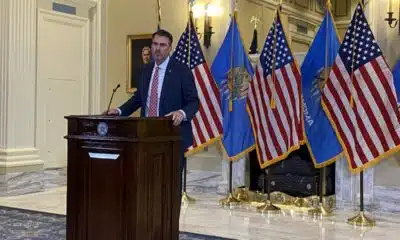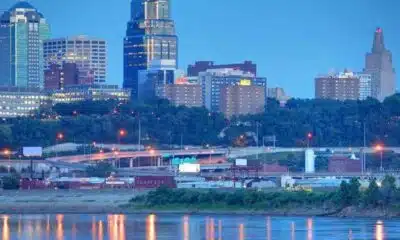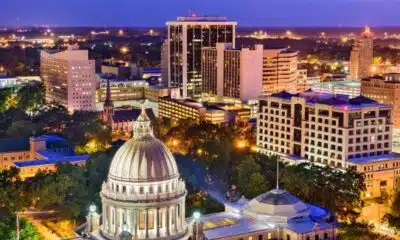News from the South - North Carolina News Feed
Does UNC Asheville’s chancellor actually live in the house? What did it cost? Why are the I-26 speed limit signs mismatched? • Asheville Watchdog
Today’s round of questions, my smart-aleck replies, and the real answers:

Question: I’ve never been inside the UNC Asheville chancellor’s residence, but I’m told that it’s quite large and cost a pretty penny to build. Could you provide some details about the home? How large is it? How much did it cost to build? How much to maintain? How much land razed to build? Could it house some essential workers or be sold or redeveloped? Could it maybe become a museum to forests from long ago? After all, don’t chancellors earn enough to afford their own homes?
My answer: I’m pretty sure the 3,800-acre Joyce Kilmer Memorial Forest near Robbinsville is our area’s actual tree museum, or at least a great display of old growth forest that gives an idea of what the area looked like before European settlement. Unless of course it’s already been logged under the new administration’s policies.
Real answer: UNCA spokesperson Brian Hart confirmed that Chancellor Kimberly van Noort does use the official residence, also known as the Pisgah House, as a home, as is required by the University of North Carolina university system. Specifically, he referred me to a section of the UNC policy manual and code titled, “Occupation of Official Residences of the Chancellors and the President.”
It states: “The Board of Governors reaffirms its expectation that the president of the university and the chancellors of each constituent institution will occupy their official residence and that these residences will be used for University business and functions.”
The policy also states, “that it is the policy of the Board of Governors that the president and the chancellors are required to live in their official residences as a condition of employment, except in the case where such a requirement would present a serious hardship; in any such case the president or chancellor must obtain approval from the Board of Governors, except that such approval will not be necessary if the residence is being vacated temporarily while repairs or renovations are being made.”
In June 2024, Asheville Watchdog reported on van Noort’s $300,000 base salary and perks, which include housing in the chancellor’s residence, “membership in a golf club with access to 16 courses in the Southeast, including the Country Club of Asheville, and a $900 monthly car allowance,” according to the article. That story also noted that beginning in 2025, van Noort was eligible for “incentive compensation” of up to 100 percent of her salary.
The university also pays for “utilities, maintenance, housekeeping, and groundskeeping services,” according to van Noort’s appointment letter. For the first four months of 2024, the utilities cost $3,193, then-UNCA spokesman Michael Strysick said.
The university also paid $3,458 for a security system, $13,754 for a heat pump, and $1,991 for “private property signage,” Strysick said last year.
Mountain Xpress noted in a 2014 article that the then-new $2.9 million, 6,333-square-foot chancellor’s residence had just opened and would serve as a residence but also a public space for special events.
“The two-story house replaces UNCA’s former home for its chancellor on Macon Avenue, a house that served that purpose since 1966. The university sold the home in 2007 for $600,000 and used that money, as well as private donations from about 150 people, to build the new structure,” Xpress reported.
Xpress also noted that the new home “sits on 2 acres of a 50-acre parcel of land across W.T. Weaver Boulevard from the main UNCA campus and close to the U.S. Forest Service Southern Research Station.


Question: I am wondering why the speed limit in the newly constructed area of I-26 in Henderson County changes frequently between 55 mph and 65 mph within a short period of space. It occurs more frequently going east than it does coming west. Did NCDOT fail to remove the 55 mph signs or have folks improperly uncovered the 65 mph signs too soon?
My answer: I’m pretty sure 55 mph really means 70 to 75 mph to most North Carolina drivers, so let’s not split hairs here.
Real answer: “We are currently addressing the signs,” NCDOT spokesperson David Uchiyama told me Thursday morning. “They may be updated by the time this answer is published!”
Uchiyama said the 55 mph signs in Henderson County “should have all been removed, but a few still remain.”
For the record, the speed limit is 65 mph from exits 44-49, 60 mph from exit 44-40 and 55 mph in the Buncombe County workzone.
As someone who drives I-26 just about every day, I’ve got to say these new lanes that are open are a little slice of heaven. Gives you a feel for how the interstate will flow when the whole project is finished.
NCDOT announced April 9 the opening of the new lanes on the Henderson County portion of the I-26 widening, a separate project from the widening on I-26 in Buncombe County. The news release noted that the Henderson County portion is “functionally complete and in its final pattern with final punch-list remaining.”
The total project, which started in 2019 and includes sections in Buncombe and Henderson, should wrap up next year.
The NCDOT release noted that all of the new lanes on I-26 east heading to South Carolina were opened from Airport Road (Exit 40) to U.S. 64 (Exit 49) on April 5. The stretch includes four lanes of travel from Airport Road to U.S. 25 (Exit 44) and three lanes from there to U.S. 64 (Exit 49).
The punch list includes final grinding of the concrete surface, installation of permanent pavement markings, snow-plowable markers, the addition of rumble strips, finishing of signs and other tasks, according to the release. “Many of them will require overnight closures in certain sections to safely complete the tasks,” the release noted.
New lanes on I-26 west from Hendersonville opened April 10. This stretch has four lanes from U.S. 25 to Airport Road, three lanes from Airport Road to Long Shoals Road, and two lanes through the remaining construction zone up to Brevard Road.
In Buncombe County this week, work crews opened the eastbound stretch of I-26 from Long Shoals Road to Glenn Bridge Road to three lanes, and from the bridge over Glenn Bridge Road to four lanes, where it will connect with the recently opened four-lane section beyond Airport Road, according to the NCDOT release.
This stretch of road also has a punch list, including the installation of snow-plowable reflectors, fresh lane markings, and roadside signs. It also will require some night-time closures.
The NCDOT said opening this stretch “allows crews to concentrate on the northern half of I-26 widening in Buncombe County — the stretch from Long Shoals Road to Brevard Road. The northern stretch includes the creation of a new interchange, which was added to plans after the project started, that creates a new exit providing drivers with another route to Brevard Road by the North Carolina Arboretum.”
That exit largely is being built to accommodate the Pratt & Whitney jet engine fan blade plant.
The NCDOT said other tasks on the northern section of the I-26 project “will include completion of new westbound lanes, completion of the new Blue Ridge Parkway bridge and removal of the old bridge. NCDOT officials anticipate completing final operations in late 2026.”
It’s been a long slog, folks, but it’s getting there!
Asheville Watchdog is a nonprofit news team producing stories that matter to Asheville and Buncombe County. Got a question? Send it to John Boyle at jboyle@avlwatchdog.org or 828-337-0941. His Answer Man columns appear each Tuesday and Friday. The Watchdog’s reporting is made possible by donations from the community. To show your support for this vital public service go to avlwatchdog.org/support-our-publication/.
Related
The post Does UNC Asheville’s chancellor actually live in the house? What did it cost? Why are the I-26 speed limit signs mismatched? • Asheville Watchdog appeared first on avlwatchdog.org
News from the South - North Carolina News Feed
How school bus drivers and police use AI to stop vehicle violations
SUMMARY: As the school year begins, Bus Patrol uses AI-powered cameras on over 40,000 school buses across 22 states to catch drivers illegally passing stopped buses, endangering children. In Pennsylvania’s Lower Merion School District, all 135 buses are equipped with these cameras, which activate when the stop arm extends. Drivers frequently ignore the stop sign, with violations occurring multiple times daily. Recorded violations are reviewed by police, leading to fines up to $300 for first offenses. Since installation, nearby districts have issued thousands of tickets. The system enhances enforcement, aiming to protect children by encouraging drivers to stop safely at school buses.
Transportation Correspondent Gio Benitez is in a school district outside Philadelphia that’s using the technology to help crack …
News from the South - North Carolina News Feed
In NC, Black communities meet mental health needs of youth in barbershops and churches
SUMMARY: Reggie Winston, a Raleigh barber trained in mental health first aid and suicide prevention, uses his barber chair as a safe space for Black youth to discuss mental health. Having battled undiagnosed depression himself, Winston founded Grooming Resources and Opportunities, training barbers to recognize signs of distress and suicide risk. North Carolina has launched a Black Youth Suicide Prevention Action Plan focusing on community-led support in trusted spaces like barbershops and churches. With rising suicide rates among Black youth, especially LGBTQ individuals, efforts include training barbers and faith leaders, improving cultural competence in crisis lines, and youth-led awareness campaigns to build trust and save lives.
The post In NC, Black communities meet mental health needs of youth in barbershops and churches appeared first on ncnewsline.com
News from the South - North Carolina News Feed
Biologists are using drones to scare wolves away from cattle
SUMMARY: Biologists and the Agriculture Department are using drones equipped with thermal cameras to protect cattle from wolves. The drones detect wolves near livestock and scare them away by playing sounds through loudspeakers, including fireworks, gunshots, rock songs, and most effectively, human voices like yelling or movie clips. Gray wolves, once nearly extinct, have rebounded in the U.S., posing challenges for ranchers as wolves target easier prey like cattle. Ranchers appreciate the drone technology, but worry wolves may eventually ignore the deterrents. So far, the drones have successfully reduced cattle deaths in Oregon and California.
A team of biologists working near the California-Oregon border is using drones to blast AC/DC’s “Thunderstruck,” movie clips and live human voices to shoo wolves away from cattle in an ongoing experiment.
https://abc11.com/
Download: https://abc11.com/apps/
Like us on Facebook: https://www.facebook.com/ABC11/
Instagram: https://www.instagram.com/abc11_wtvd/
Threads: https://www.threads.net/@abc11_wtvd
TIKTOK: https://www.tiktok.com/@abc11_eyewitnessnews
-
Mississippi Today3 days ago
DEI, campus culture wars spark early battle between likely GOP rivals for governor in Mississippi
-
Mississippi Today7 days ago
Judge: Felony disenfranchisement a factor in ruling on Mississippi Supreme Court districts
-
News from the South - North Carolina News Feed5 days ago
Parasocial party: Why people are excited for the Taylor Swift, Travis Kelce engagement
-
News from the South - Louisiana News Feed6 days ago
K+20: Katrina alters local health care landscape, though underlying ills still the same
-
Our Mississippi Home6 days ago
The Great Backyard Recovery – Helping Birds After the Storm
-
The Center Square6 days ago
U-M Health ends transgender treatment for minors | Michigan
-
Local News Video4 days ago
08/29 Ryan's “Wet End to the Week” Friday Forecast
-
News from the South - Florida News Feed6 days ago
Man who shot ex-girlfriend died after shootout with deputies at apartment complex, MDSO says












































